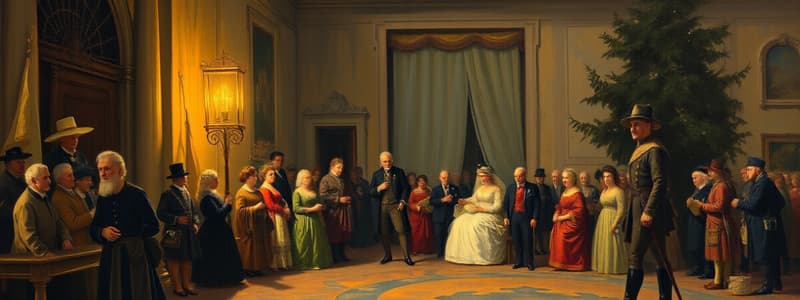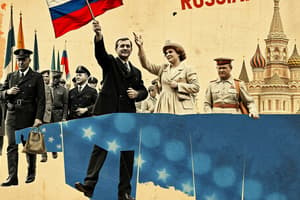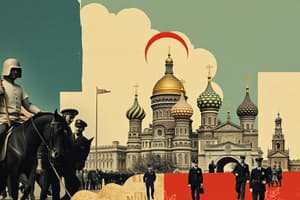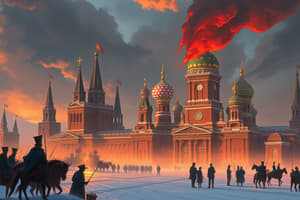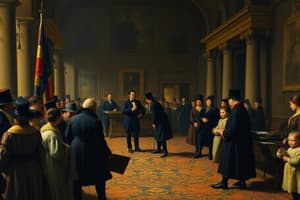Podcast
Questions and Answers
What characterized the reform efforts under Tsar Nicholas II during his reign?
What characterized the reform efforts under Tsar Nicholas II during his reign?
- Reforms faced no opposition from the populace.
- Reforms were implemented swiftly and effectively.
- Reform efforts aimed to completely democratize Russia.
- Reforms were often accompanied by repressive measures. (correct)
What was the primary purpose of the Duma established after the 1905 Revolution?
What was the primary purpose of the Duma established after the 1905 Revolution?
- To create a completely new government structure.
- To eliminate the need for a Tsar altogether.
- To pacify liberal opposition and maintain autocratic control. (correct)
- To provide a platform for total democratic control.
Which event led to the significant strains on the tsarist autocratic government just before the Provisional Government was established?
Which event led to the significant strains on the tsarist autocratic government just before the Provisional Government was established?
- The establishment of the Duma.
- The assassination of Tsar Nicholas II.
- The October Revolution.
- The economic collapse during the First World War. (correct)
What was the consequence of Tsar Nicholas II taking control of the army in 1915?
What was the consequence of Tsar Nicholas II taking control of the army in 1915?
How did censorship affect the society in Russia before 1914?
How did censorship affect the society in Russia before 1914?
What did the Fundamental Laws of 1906 ensure regarding the Duma?
What did the Fundamental Laws of 1906 ensure regarding the Duma?
What key slogan did the Bolsheviks use to rally support among the peasants?
What key slogan did the Bolsheviks use to rally support among the peasants?
What was a consequence of Russia's involvement in World War I?
What was a consequence of Russia's involvement in World War I?
What was the nature of challenges to the Tsar's authority before 1914?
What was the nature of challenges to the Tsar's authority before 1914?
What decision made by the Provisional Government undermined its support among the peasants?
What decision made by the Provisional Government undermined its support among the peasants?
What perception arose from moving the Constituent Assembly elections to November?
What perception arose from moving the Constituent Assembly elections to November?
Which of the following was NOT a significant reform instituted by the Provisional Government?
Which of the following was NOT a significant reform instituted by the Provisional Government?
What factor was NOT mentioned as contributing to the Provisional Government's limited effectiveness?
What factor was NOT mentioned as contributing to the Provisional Government's limited effectiveness?
How did the decision of the Land Commission impact the Provisional Government?
How did the decision of the Land Commission impact the Provisional Government?
Which of the following was a major limitation of the reforms implemented by the Provisional Government?
Which of the following was a major limitation of the reforms implemented by the Provisional Government?
What was the general sentiment towards the Provisional Government by the time of the elections?
What was the general sentiment towards the Provisional Government by the time of the elections?
What significant change in governance occurred after Nicholas II's authority was signed away?
What significant change in governance occurred after Nicholas II's authority was signed away?
Which of the following was not one of the eight principles of liberal reforms enacted by the Provisional Government?
Which of the following was not one of the eight principles of liberal reforms enacted by the Provisional Government?
What was one of the limitations faced by the Provisional Government in implementing reforms?
What was one of the limitations faced by the Provisional Government in implementing reforms?
What major legislative body did the Provisional Government pave the way for through its reforms?
What major legislative body did the Provisional Government pave the way for through its reforms?
How did Lenin describe the new changes in Russia following the February Revolution?
How did Lenin describe the new changes in Russia following the February Revolution?
Which change was introduced under the Provisional Government regarding judiciary matters?
Which change was introduced under the Provisional Government regarding judiciary matters?
Which aspect played a significant role in the failures of the Provisional Government?
Which aspect played a significant role in the failures of the Provisional Government?
What was a significant outcome of the freedoms granted to the Russian people during the Provisional Government period?
What was a significant outcome of the freedoms granted to the Russian people during the Provisional Government period?
Which of the following reforms aimed to address labor rights?
Which of the following reforms aimed to address labor rights?
What was one of the primary reasons behind the radical reforms of the Provisional Government?
What was one of the primary reasons behind the radical reforms of the Provisional Government?
What did the Provisional Government abolish as part of its reforms?
What did the Provisional Government abolish as part of its reforms?
How did the Provisional Government's reforms impact the political landscape of Russia?
How did the Provisional Government's reforms impact the political landscape of Russia?
What was a major consequence of the Provisional Government's continued involvement in World War I?
What was a major consequence of the Provisional Government's continued involvement in World War I?
Which of the following reforms was aimed at reducing class and social barriers?
Which of the following reforms was aimed at reducing class and social barriers?
Flashcards are hidden until you start studying
Study Notes
Context of Russian Autocracy Before 1914
- Russia was under autocratic Tsarist rule since 1547, with the Romanovs in power from 1613.
- Authority challenges were harshly suppressed, leading to minimal reform.
- Censorship and a rigid social structure stifled political expression.
- Reforms were often rolled back through repressive measures.
Tsarist Reforms and Limitations
- The Duma was created after the 1905 Revolution as a response to increasing dissent.
- The October Manifesto aimed to pacify liberals but was used to undermine opposition.
- Fundamental Laws (1906) maintained Tsarist authority with complex voting systems and a veto power.
- The Tsarist state remained strong before WWI, surviving reforms and repression since 1855.
Impact of WWI on Russia
- The First World War caused severe economic collapse and food shortages impacting major cities.
- Nicholas II’s decision to lead the army in 1915 removed him from central governance.
- Growing discontent and tension culminated in the Progressive Bloc in the Duma, advocating a state without the Tsar.
- Nicholas II’s abdication was swift, reflecting the changed political climate.
Reforms by the Provisional Government
- Introduced significant liberal reforms through eight key principles:
- Political prisoners received amnesty, including terrorists.
- Freedoms of speech, assembly, and the right to strike were established.
- Abolished privileges based on religion, nationality, or class.
- Prepared for a Constituent Assembly with universal suffrage.
- Replaced police with locally elected militia officers.
- Recognized trade unions and introduced an eight-hour workday.
- Established trial by jury; abolished capital punishment and exile.
- Censorship was lifted, fostering open political discussions.
Limitations of the Provisional Government
- Had to continue fighting in WWI, limiting focus on urgent domestic issues.
- Lacked legitimacy as a placeholder for the forthcoming Constituent Assembly.
- Struggled with the "land question," unable to address peasant demands.
Constituent Assembly Elections and Their Significance
- The hope for a truly representative government led to high expectations for the Constituent Assembly.
- Elections in November 1917 were free, yet the Provisional Government's reluctance to address pressing issues diminished goodwill.
- Despite passing broad reforms, the Provisional Government's inability to solve major problems contributed to its downfall.
Impact of Reforms on Society
- Civil liberties expanded significantly, enabling public political engagement and activism.
- Freedoms led to mobilization against the Provisional Government, culminating in uprisings like the July Days and the Bolshevik Revolution.
- The removal of controls prompted rising demands for further change, yet also destabilized the Provisional Government's authority.
Consequences of Decisions Made
- Ignoring the land issue alienated peasants, who would seize land without waiting for government action, aligning with Bolshevik calls for "Peace, Bread, Land."
- Moving Constituent Assembly elections to November raised suspicions of the Provisional Government's intentions, fueling beliefs it sought to retain power illegitimately.
Conclusion
- Although reforms under the Provisional Government were substantial, their impact was ultimately limited by ongoing war pressures, unresolved social issues, lack of legitimacy, and the influence of the Petrograd Soviet.
- The inability to enact necessary reforms significantly weakened the Provisional Government, leading to its collapse in October 1917.
Studying That Suits You
Use AI to generate personalized quizzes and flashcards to suit your learning preferences.
